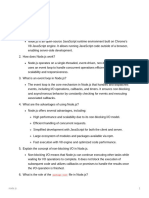0% found this document useful (0 votes)
18 views16 pagesMERN Stack Interview Questions
The document outlines essential MERN Stack interview questions and answers, covering key technologies such as MongoDB, Express, React, and Node.js. It provides insights into the roles of a MERN Stack Developer, various concepts like MVC architecture, and specific features of each technology. Additionally, it discusses important topics like RESTful APIs, Redux, and the differences between class and functional components in React.
Uploaded by
Faiz ullahCopyright
© © All Rights Reserved
We take content rights seriously. If you suspect this is your content, claim it here.
Available Formats
Download as PDF, TXT or read online on Scribd
0% found this document useful (0 votes)
18 views16 pagesMERN Stack Interview Questions
The document outlines essential MERN Stack interview questions and answers, covering key technologies such as MongoDB, Express, React, and Node.js. It provides insights into the roles of a MERN Stack Developer, various concepts like MVC architecture, and specific features of each technology. Additionally, it discusses important topics like RESTful APIs, Redux, and the differences between class and functional components in React.
Uploaded by
Faiz ullahCopyright
© © All Rights Reserved
We take content rights seriously. If you suspect this is your content, claim it here.
Available Formats
Download as PDF, TXT or read online on Scribd
/ 16






















































































